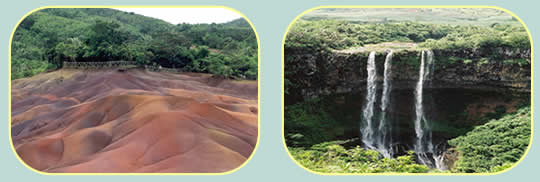Island Info
The shores of Mauritius are located some 500 miles off the east coast of Madagascar, just north of the Tropic of Capricorn at latitude 20 degrees south and longitude 57 degrees, 35 minutes east. The island’s 200 mile coastline is virtually encircled by one of the world’s largest unbroken coral reef systems. It is part of the African continent, rising from the sea in a series of volcanic eruptions over 8 million years ago. It is also the best known of the Mascarene Islands which also include Reunion and Rodrigues Islands.

Time
GMT + 4. Mauritius is 4 hours ahead (3 hours during the European summer) of Greenwich Mean Time. Noon in Mauritius is 3:00 AM in New York and midnight in Los Angeles.
Climate And Best Season to Visit
Mauritius is a great year round destination with little temperature variation. There are basically two seasons from Dec – April warm and occasional rain (v little in fact) and cool and dry from May-November.
Temperatures on average are :-
Jan |
Feb |
Mar |
Apr |
May |
Jun |
Jul |
Aug |
Sep |
Oct |
Nov |
Dec |
30c |
29c |
29c |
28c |
26c |
24c |
24c |
24c |
25c |
27c |
28c |
29c |
The coast is generally around 8 degrees F warmer than the Central Plateau…and it’s quite possible for it to rain in one locale and not in the other, even though physical distance is not great. Summer, from January through April, can be hot and humid with daytime temps averaging in the high 80’s. There are no distinct monsoons and rain is possible on any day of the year. The wind blows either from the north or from the regular trade winds blowing from the southeast. The winter season lasts from July to September, and is completely and perfectly pleasant. Daytime temperatures range to the high 70’s, falling to high 50’s at night, with less rain and humidity.
Places of Interest
Below are just a few suggestions for places of interest to visit on your holiday in Mauritius as an alternative to the beach:
Black River Gorges National Park with its original jungle and bird life which exists only in Mauritius (the Pink Pigeon, the Echo Parakeet and the Mauritius Kestrel; all very rare species). Several walking-tours; Alexander Waterfalls.

Bois Chéri: Visit the tea production, enjoy the mauritian cuisine in a colonial house built in 1819.
Chamarel and the coloured earth: Place in the south-west with pilgrimage church. Remarkably seven-coloured earth (left image) for which there isn’t any scientific explanation till now and the Chamarel waterfall (right image).

Domaine de l´Ylang Ylang: Ylang Ylang plantation in Vieux Grand Port. A visit of the plantation is a must for every nature-lover. Lovely situated restaurant.
Domaine Les Pailles: Experience the original Mauritius. Traditional sugar production, Landrover safaris and animation for children. The restaurants are part of the best of Mauritius.Casino of the luxury class.
Domaine du Chasseur: Experiencing the nature of Mauritius. Walks for animal and nature lovers. Restaurant of the top class.
 Pamplemousses gardens: A brilliant and novel specimen of age old botanical gardens which were established by a French governor 300 years back. The gardens happen to be a thick collection of palm trees and Queen Victoria water lilies. The botanical gardens served as a center of horticultural research for the British and the French in the colonial era. Java deers and Gazebos are too found in the Sir Seewoosagur Ramgoolam botanical Island which is the other name for the Pamplemousses gardens located in Mauritius.
Pamplemousses gardens: A brilliant and novel specimen of age old botanical gardens which were established by a French governor 300 years back. The gardens happen to be a thick collection of palm trees and Queen Victoria water lilies. The botanical gardens served as a center of horticultural research for the British and the French in the colonial era. Java deers and Gazebos are too found in the Sir Seewoosagur Ramgoolam botanical Island which is the other name for the Pamplemousses gardens located in Mauritius.